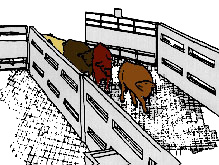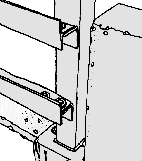 |
A good example of a non-slick surface for livestock. |
 |
A good example of a non-slick surface for livestock. |
New concrete floors for cattle should have an 8-inch diamond or square pattern with 1 1/2 inch (3.5cm) x 1 1/2 inch (3.5cm) V grooves. For pigs and sheep, stamp the pattern of 1 1/2 inch (3.5cm) raised expanded metal into the wet concrete. A rough broom finish will become worn smooth. Floors should be grooved. It is also essential to use the right concrete mix for maximum resistance to wear.
| Example of a bad fence corner. Notice the protruding sharp edges that could cut an animal as well as cause serious bruising. Cattle can be severly bruised with no visible damage to the hide. |  |
Gates, fences and chutes should have smooth surfaces to prevent bruises. Sharp edges with a small diameter, such as angle irons, exposed pipe ends, and channels, will cause bruises. Round pipe posts with a diameter larger than 3 inches (7.6cm) are less likely to bruise. Vertical slide gates in chutes should be counter-weighted to prevent back bruises. The bottom of these gates should be padded with cut tires or conveyor belting. The gate track should be recessed into the chute wall to eliminate a sharp edge that will bruise. Gates in drive alleys should be equipped with tie backs to prevent them from swinging out into the alley. Livestock are easily bruised if they become caught between the end of the gate and the fence. This is a common cause of bruises in the valuable loin area.
 |
Gates should be tied back to prevent balking as animals are entering the lead up chute. Once the animals are in the chute, the gates should be lowered to prevent the animals from backing out of the chute. |
Pressing up against a smooth flat surface such as a concrete chute fence will not cause bruises. However, a protruding bolt or piece of metal will damage hides and bruise the meat. Bruise points can be detected by tufts of hair or a shiny surface. Contrary to popular belief, livestock can be bruised moments before slaughter, and stunned cattle can be bruised until they are bled. The entrance to the restrainer should be inspected often for broken parts with sharp edges.
Surveys show that groups of horned cattle will have twice as many bruises as polled (hornless) cattle. A few horned animals can do a lot of damage and tipping horns does not reduce bruises.
 Grandin, T. (2001) How to Track Down the Cause of Bruising. Dept. of Animal Science. Colorado State University. Fort Collins, CO, 80523.
Grandin, T. (2001) How to Track Down the Cause of Bruising. Dept. of Animal Science. Colorado State University. Fort Collins, CO, 80523.
 Grandin, T. (1995) Bruise levels on fed and non-fed cattle. (pages 193-201). Proceedings Livestock Conservation Institute. 1910 Lyda Drive, Bowling Green, Kentucky 42104 USA.
Grandin, T. (1995) Bruise levels on fed and non-fed cattle. (pages 193-201). Proceedings Livestock Conservation Institute. 1910 Lyda Drive, Bowling Green, Kentucky 42104 USA.
 Grandin, T. (1995) Restraint of Livestock. Proceedings from:
Animal Behavior and the Design of Livestock and Poultry Systems International Conference. Indianapolis, Indiana. April 19-21 (pages 208-223). Published by: Northeast Regional Agriculture Engineering Service, Cooperative Extension, 152 Riley - Robb Hall, Ithaca, New York, 14853, USA.
Grandin, T. (1995) Restraint of Livestock. Proceedings from:
Animal Behavior and the Design of Livestock and Poultry Systems International Conference. Indianapolis, Indiana. April 19-21 (pages 208-223). Published by: Northeast Regional Agriculture Engineering Service, Cooperative Extension, 152 Riley - Robb Hall, Ithaca, New York, 14853, USA.
 Grandin, T. (2010) Improving Animal Welfare: A Practical Approach. CABI Publishing, Wallingford, Oxfordshire, UK.
Grandin, T. (2010) Improving Animal Welfare: A Practical Approach. CABI Publishing, Wallingford, Oxfordshire, UK.
 Click here to return to the Homepage for more information on animal behavior, welfare, and care.
Click here to return to the Homepage for more information on animal behavior, welfare, and care.